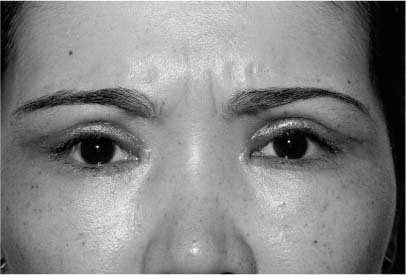4 The facial unit consisting of the eyebrows and forehead forms an important aesthetic component of the face and frequently benefits from surgical rejuvenation. In general, the distance between the brow and lashes of the upper eyelid is greater in Asians than in Caucasians. Furthermore, horizontal furrows tend to be less common perhaps due to increased dermal thickness as well as the presence of more abundant adipose tissue in the supragaleal plane, factors that reduce transmission of visible evidence of frontalis activity to the forehead skin. For these reasons, I find that indications for brow lift surgery are less common in Asians. My patients rarely request brow lifting procedures (unless they have actually seen one of my postoperative results); the majority are undertaken after I inform the patient that, in my aesthetic judgment, the appearance of the periorbital region would be enhanced by elevation of the brow. Indeed, many of my patients who request blepharoplasty have come to my office seeking a second opinion following recommendations by other surgeons for a coronal brow lift procedure. By far, the most common reason that I perform brow lift surgery in Asian patients is to rejuvenate a ptotic brow that has become aesthetically apparent years following upper blepharoplasty. Because of the relative lack of importance of forehead rhytidosis, by far the most common procedure I perform for brow lifting is the direct suprabrow approach. In spite of the general principle that lifting procedures are more accurate the closer the incision is placed to the structure requiring lifting, many surgeons have decried the suprabrow lift operation because of the possibility of visible scars. The enthusiasm, however, of Asian patients to undergo micropigmentation of the eyelids and brow provides a significant margin of safety regarding the issue of postoperative scars and has been proven to be extremely effective if necessary. (Chapter 13 covers the latest techniques for micropigmentation in detail.) For reasons to be discussed, there is no question that the accuracy and precision of eyebrow placement provided by direct suprabrow lifting exceeds that of coronal forehead lifting when performed by either open or endoscopic methods. As noted above, suprabrow and coronal forehead lifts are most commonly performed as a late sequel to upper-lid blepharoplasty, especially in cases in which creation of a large “double lid” with a deep palpebral sulcus (i.e., “westernization” of the eyelid; this situation does not occur following the more conservative “double lid” surgery) produces, most commonly in older patients, an apparent descent of the brow associated with deepening of glabellar frown lines, a combination that produces an angry look (Fig. 4-1). The decision whether to recommend a coronal forehead lift or a direct suprabrow lift depends on at least three factors: Figure 4-1 An angry look associated with an apparent brow descent and deepening of the glabellar frown lines following westernization of the upper eyelid. Many patients, for example, are comfortable camouflaging forehead wrinkles with bangs, and are thus happy with the improvement in brow ptosis afforded by a direct suprabrow lift, a much simpler (and more accurate) procedure than a coronal forehead lift. The corrugator muscles responsible for glabellar furrows can be subtotally resected (although perhaps not as effectively as via the forehead lift exposure) during this procedure, if requested. Patients who express concerns about deeper horizontal forehead wrinkles are obvious candidates for a coronal forehead lift as opposed to a direct brow lift. As noted previously, Asian patients have enthusiastically embraced the technique of micropigmentation of the eyelids and brows, and use of this technique for camouflage of residual brow scars following suprabrow lifting has essentially obviated previous concerns about undesirable scars that occasionally follow this procedure. Assuming that the general principle that the effectiveness of the “lift” of a facial component is directly related to the proximity of the surgical incision to that structure is valid, an accurate and long-lasting brow lift can be achieved with the suprabrow lift procedure. Following skin excision, the frontalis muscle and underlying soft tissue within the wound are excised to the level of the periosteum. If indicated, the corrugator supercilii muscles are approached via the medial aspect of the wound. This is a semi-blind procedure, and accuracy relies on the surgeon’s anatomic knowledge of corregator anatomy. Although the excision can be initiated with small dissecting scissors, the majority of the technique is best achieved with an avulsion technique using tissue forceps, avulsion being less likely to injure the neurovascular bundle that courses through the corrugator musculature. In cases in which subtotal corrugator resection is undertaken, the glabellar skin is undermined to accommodate a thin sheet of expanded poly-tetrafluoroethylene (Gore-Tex) that is placed into the wound for two purposes:
Cosmetic Surgery of the Asian Brow and Forehead
♦ Anatomic Considerations
♦ Preoperative Considerations
♦ Direct Suprabrow Lift
Surgical Technique
Stay updated, free articles. Join our Telegram channel

Full access? Get Clinical Tree









